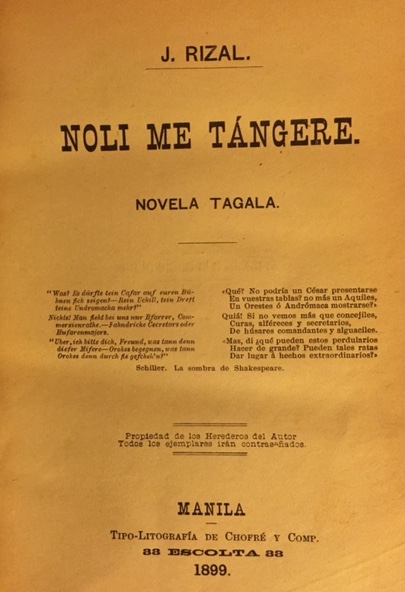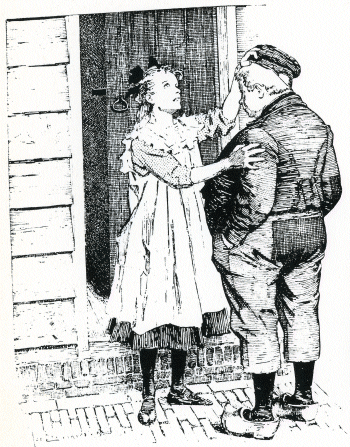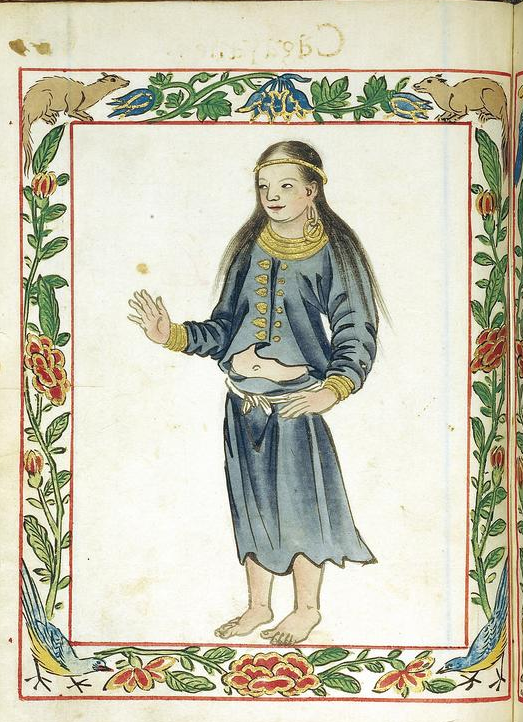|
María Clara
María Clara, whose full name is María Clara de los Santos y Alba, is the ''mestiza'' heroine in '' Noli Me Tángere'', a novel by José Rizal, the national hero of the Philippines. Her name and character have since become a byword in Filipino culture for the traditional, feminine ideal. María Clara is the childhood sweetheart and fiancée of ''Noli Me Tángere''s main protagonist, Juan Crisóstomo Ibarra y Magsalin, the son of Don Rafael Ibarra. Although raised as the daughter of Captain Santiago "Kapitán Tiyago" de los Santos and his wife Doña Pía Alba, who are both native Filipinos, María Clara is revealed to have been the illegitimate daughter of ''Padre'' Dámaso, a Spanish friar, who coerced Doña Pía into illicit sexual relations. Dámaso is made the girl's godfather; Doña Pía had died giving birth to Mariá Clara. Kapitán Tiyago's cousin, Tía Isabel, then came to be the dominant maternal figure in her life. As her beau Crisóstomo Ibarra was studying in ... [...More Info...] [...Related Items...] OR: [Wikipedia] [Google] [Baidu] |
Noli Me Tángere (novel)
''Noli Me Tángere'' (Latin for "''Touch me not''") is an 1887 novel by Filipino writer and activist José Rizal published during the Spanish colonial period of the Philippines. It explores perceived inequities in law and practice in terms of the treatment by the ruling government and the Spanish Catholic friars of the resident peoples a hundred years ago. Originally written by Rizal in Spanish, the book has since been more commonly published and read in the Philippines in either Tagalog (the major indigenous language), or English. The Rizal Law requires ''Noli'' and its sequel, '' El filibusterismo'' to be read by all high school students throughout the country. ''Noli'' is studied in Grade 9 and in Grade 10. The two novels are widely considered to be the national epic of the Philippines. They have been adapted in many forms, such as operas, musicals, plays, and other forms of art. The title originates from the Biblical passage John 20:13-17. In Rizal's time it also refe ... [...More Info...] [...Related Items...] OR: [Wikipedia] [Google] [Baidu] |
Europe
Europe is a large peninsula conventionally considered a continent in its own right because of its great physical size and the weight of its history and traditions. Europe is also considered a Continent#Subcontinents, subcontinent of Eurasia and it is located entirely in the Northern Hemisphere and mostly in the Eastern Hemisphere. Comprising the westernmost peninsulas of Eurasia, it shares the continental landmass of Afro-Eurasia with both Africa and Asia. It is bordered by the Arctic Ocean to the north, the Atlantic Ocean to the west, the Mediterranean Sea to the south and Asia to the east. Europe is commonly considered to be Boundaries between the continents of Earth#Asia and Europe, separated from Asia by the drainage divide, watershed of the Ural Mountains, the Ural (river), Ural River, the Caspian Sea, the Greater Caucasus, the Black Sea and the waterways of the Turkish Straits. "Europe" (pp. 68–69); "Asia" (pp. 90–91): "A commonly accepted division between Asia and E ... [...More Info...] [...Related Items...] OR: [Wikipedia] [Google] [Baidu] |
Girl Next Door
The girl next door is a young female stock character who is often used in romantic stories. She is so named because she often lives next door to the protagonist or is a childhood friend. They start out with a mutual friendship that later often develops into romantic attraction. A similar expression is " boy next door". Characteristics A "girl next door" character is often seen as natural and unpretentious. A trope that evokes nostalgia, it is associated with small towns and more local or even rural ways of life. The girl next door is often portrayed as innocent. Doris Day of the 1950s is described as a pioneering embodiment of the "girl next door" image in film, the "Hollywood's girl next door". A common cliche is when a male protagonist is caught in a love triangle between two women, he will usually choose the "sweet, ordinary, and caring girl next door" he grew up with rather than a more well-off or beautiful woman with fewer morals. Other times, this character ignores t ... [...More Info...] [...Related Items...] OR: [Wikipedia] [Google] [Baidu] |
English Rose (epithet)
English rose is a description, associated with English culture, that may be applied to a naturally beautiful woman or girl who is from or is associated with England. It can also be used as a veiled insult - as a rose will bloom and fade so may a woman have great beauty in her youth but then quickly lose it. The description has a cultural reference to the national flower of England, the rose, and to its long tradition within English symbolism. Use in arts The term "English rose" is found in ''Merrie England'' (1902), a comic opera written by Basil Hood. He describes a garden where "women are the flowers" and in which "the sweetest blossom" or "fairest queen" is "the perfect English rose". The words are performed by a tenor in the role of Sir Walter Raleigh (1554–1618), in the presence of a May Queen, but regarding his secret love ''(purely within the opera)'', a member of the household of Elizabeth I. One song by the rock band the Jam taken from their album All Mod Con ... [...More Info...] [...Related Items...] OR: [Wikipedia] [Google] [Baidu] |
Cult Of Domesticity
The Culture of Domesticity (often shortened to Cult of Domesticity) or Cult of True Womanhood is a term used by historians to describe what they consider to have been a prevailing value system among the upper and middle classes during the 19th century in the United States. This value system emphasized new ideas of femininity, the woman's role within the home and the dynamics of work and family. "True women", according to this idea, were supposed to possess four cardinal virtues: piety, purity, domesticity, and submissiveness. The idea revolved around the woman being the center of the family; she was considered "the light of the home". The women and men who most actively promoted these standards were generally white and Protestant; the most prominent of them lived in New England and the Northeastern United States. Although all women were supposed to emulate this ideal of femininity, black, working class, and immigrant women were often excluded from the definition of "true women" bec ... [...More Info...] [...Related Items...] OR: [Wikipedia] [Google] [Baidu] |
María Clara Gown
The María Clara gown, historically known as the ''traje de mestiza'' during the Spanish colonial era, is a type of traditional dress worn by women in the Philippines. It is an aristocratic version of the '' baro't saya''. It takes its name from María Clara, the mestiza protagonist of the novel '' Noli Me Tángere'', penned in 1887 by Filipino nationalist José Rizal. It is traditionally made out of piña, the same material used for the '' barong tagalog''.Moreno, Jose "Pitoy"– Maria Clara Philippine Costume, koleksyon.com, archived from the original on July 13, 2011. A unified gown version of the dress with butterfly sleeves popularized in the first half of the 20th century by Philippine National Artist Ramon Valera is known as the ''terno'', which also has a shorter casual and cocktail dress version known as the ''balintawak''. The masculine equivalent of ''baro't saya'' is the '' barong tagalog''. These traditional women's dresses in the Philippines are collectively ... [...More Info...] [...Related Items...] OR: [Wikipedia] [Google] [Baidu] |
Eponym
An eponym is a person, a place, or a thing after whom or which someone or something is, or is believed to be, named. The adjectives which are derived from the word eponym include ''eponymous'' and ''eponymic''. Usage of the word The term ''eponym'' functions in multiple related ways, all based on an explicit relationship between two named things. A person, place, or thing named after a particular person share an eponymous relationship. In this way, Elizabeth I of England is the eponym of the Elizabethan era. When Henry Ford is referred to as "the ''eponymous'' founder of the Ford Motor Company", his surname "Ford" serves as the eponym. The term also refers to the title character of a fictional work (such as Rocky Balboa of the Rocky film series, ''Rocky'' film series), as well as to ''self-titled'' works named after their creators (such as the album The Doors (album), ''The Doors'' by the band the Doors). Walt Disney created the eponymous The Walt Disney Company, Walt Disney Com ... [...More Info...] [...Related Items...] OR: [Wikipedia] [Google] [Baidu] |
Masochism
Sadomasochism ( ) is the giving and receiving of pleasure from acts involving the receipt or infliction of pain or humiliation. Practitioners of sadomasochism may seek sexual pleasure from their acts. While the terms sadist and masochist refer respectively to one who enjoys giving and receiving pain, some practitioners of sadomasochism may switch between activity and passivity. The abbreviation S&M is commonly used for Sadomasochism (or Sadism & Masochism), although the initialisms S-M, SM, or S/M are also used, particularly by practitioners. Sadomasochism is not considered a clinical paraphilia unless such practices lead to clinically significant distress or impairment for a diagnosis. Similarly, sexual sadism within the context of mutual consent, generally known under the heading BDSM, is distinguished from non-consensual acts of sexual violence or aggression.:"Sexual arousal from consensual interactions that include domination should be distinguished from nonconsensual sex ... [...More Info...] [...Related Items...] OR: [Wikipedia] [Google] [Baidu] |
Chastity
Chastity, also known as purity, is a virtue related to temperance. Someone who is ''chaste'' refrains either from sexual activity considered immoral or any sexual activity, according to their state of life. In some contexts, for example when making a vow of chastity, chastity means the same as celibacy. Etymology The words ''chaste'' and ''chastity'' stem from the Latin adjective ("cut off", "separated", "pure"). The words entered the English language around the middle of the 13th century. ''Chaste'' meant "virtuous", "pure from unlawful sexual intercourse") or (from the early 14th century on) as a noun, a virgin, while ''chastity'' meant "(sexual) purity". Thomas Aquinas links ''(chastity)'' to the Latin verb ("chastise, reprimand, correct"), with a reference to Aristotle's Nicomachean Ethics: "Chastity takes its name from the fact that reason 'chastises' concupiscence, which, like a child, needs curbing, as the Philosopher states". In Abrahamic religions For many Jews, ... [...More Info...] [...Related Items...] OR: [Wikipedia] [Google] [Baidu] |
Intramuros
Intramuros (Latin for "inside the walls") is the historic walled area within the city of Manila, the capital of the Philippines. It is administered by the Intramuros Administration with the help of the city government of Manila. Present-day Intramuros comprises a centuries-old historic district, entirely surrounded by fortifications, that was considered at the time of the Spanish Empire to be the entire City of Manila. Other towns and ''arrabales'' (suburbs) located beyond the walls that are now districts of Manila were referred to as ''extramuros'', Latin language, Latin for "outside the walls", and were independent towns that were only incorporated into the city of Manila during the early 20th century. Intramuros served as the seat of government of the Captaincy General of the Philippines, a component realm of the Spanish Empire, housing the colony's governor-general from its founding in 1571 until 1865, and the Real Audiencia of Manila until the end of Spanish rule during th ... [...More Info...] [...Related Items...] OR: [Wikipedia] [Google] [Baidu] |
Eurasian
Eurasia (, ) is the largest continental area on Earth, comprising all of Europe and Asia. Primarily in the Northern and Eastern Hemispheres, it spans from the British Isles and the Iberian Peninsula in the west to the Japanese archipelago and the Russian Far East to the east. The continental landmass is bordered by the Atlantic Ocean and Africa to the west, the Pacific Ocean to the east, the Arctic Ocean to the north, and by Africa, the Mediterranean Sea, and the Indian Ocean to the south. The division between Europe and Asia as two continents is a historical social construct, as many of their borders are over land; thus, in some parts of the world, Eurasia is recognized as the largest of the six, five, or four continents on Earth. In geology, Eurasia is often considered as a single rigid megablock. However, the rigidity of Eurasia is debated based on paleomagnetic data. Eurasia covers around , or around 36.2% of the Earth's total land area. It is also home to the largest ... [...More Info...] [...Related Items...] OR: [Wikipedia] [Google] [Baidu] |
Women In The Philippines
The role of women in the Philippines ( fil, Kababaihan sa Pilipinas) is explained based on the context of Filipino culture, standards, and mindsets. The Philippines is described to be a nation of strong women, who directly and indirectly run the family unit, businesses, government agencies and haciendas. Although they generally define themselves in the milieu of a male-dominated post-colonial society, Filipino women live in a culture that is focused on the community, with the family as the main unit of society, but not always according to this stereotype. It is in this framework of Philippine hierarchical structure, class differences, religious justifications, and living in a globally developing nation wherein Filipino women struggle for respect. Compared to other parts of Southeast Asia, women in Philippine society have always enjoyed a greater share of equality.Clamonte, Nitz. Women in the Philippines, Compiled fro''Gender Awareness Seminars'' developed and facilitated by Nit ... [...More Info...] [...Related Items...] OR: [Wikipedia] [Google] [Baidu] |



_(14580123410).jpg)


.png)

_by_Brambila.jpg)
